Unplugged: Legacy of Yu (Boardgame)
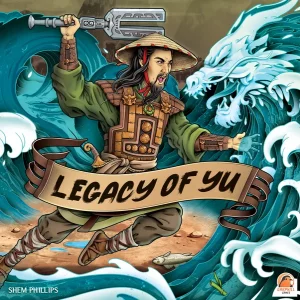 While fans of wargaming have been playing both sides of a battle for decades, the idea of playing a boardgame solo has recently seen a large uptick in broader gaming circles. Many boardgames advertise a “solo mode”, allowing gamers to play even if, for whatever reason, they are unable to arrange for a meet-up to play a game. A few games, like Legacy of Yu, take things a step further and are designed solely for one player. Designed from the ground up as a solo game it has an advantage over other single-player options since it isn’t just an add-on option (perhaps an afterthought) to a multiplayer game. Legacy of Yu does a stellar job of providing an interesting solo experience that manages not to outstay its welcome through the use of an ongoing story arc that slightly adjusts the difficulty between games.
While fans of wargaming have been playing both sides of a battle for decades, the idea of playing a boardgame solo has recently seen a large uptick in broader gaming circles. Many boardgames advertise a “solo mode”, allowing gamers to play even if, for whatever reason, they are unable to arrange for a meet-up to play a game. A few games, like Legacy of Yu, take things a step further and are designed solely for one player. Designed from the ground up as a solo game it has an advantage over other single-player options since it isn’t just an add-on option (perhaps an afterthought) to a multiplayer game. Legacy of Yu does a stellar job of providing an interesting solo experience that manages not to outstay its welcome through the use of an ongoing story arc that slightly adjusts the difficulty between games.
Legacy of Yu
Designer: Shem Phillips
Publisher: Renegade Game Studios
Players: 1
Ages: 12+
Time: 60min
(review copy provided by publisher)
Legacy of Yu has players attempting to create an irrigation system across the top of the board ahead of the oncoming flood that moves from right to left. Meanwhile, players must beat back (or at least delay) barbarian cards that arrive at the top of the board and slowly shift off to the left. This is all done through spending resources, initially from playing townsfolk cards but eventually from additional locations on the game board. While the game could be seen as almost exclusively a resource-spending game, one of the resources is various colored worker pieces. The game often requires a specific colored worker but white workers are required for building canals or other buildings. These can be spent and returned in such a way that resources (including other workers) are gained, giving that portion of the game a strong worker-placement feel. Other resources include clay, wood, provisions, and shells. Wood and Clay are used for buildings, provisions usually involve hiring more townsfolk and fighting barbarians. Shells are more of a general good, often used to replace or supplement other goods.
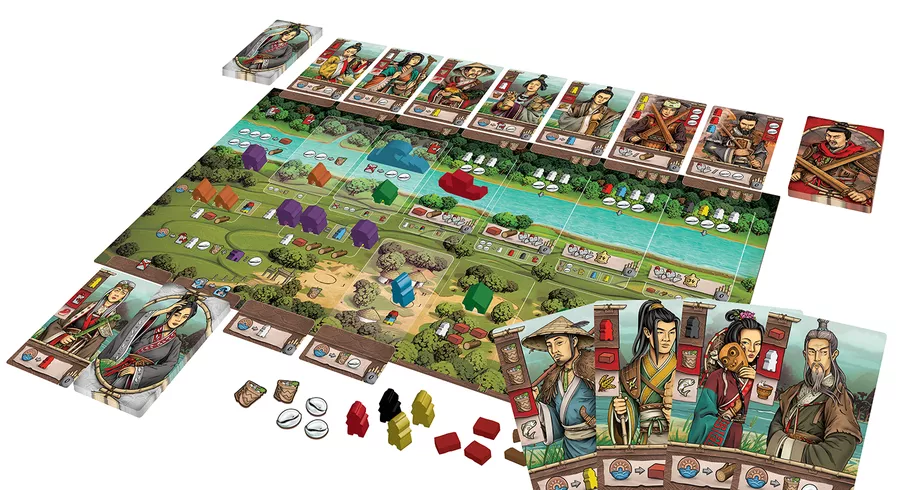
There are several ways to lose a game. The flood can progress ahead of the player’s canals, too many barbarians can clog up the tableau, or a player can simply run out of townsfolk cards in their deck. To win, a player must complete the final canal section and survive (not lose) until the end of the current round.
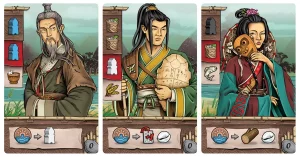
Players start out by drawing a hand of cards from their small deck of townsfolk cards. These cards are played to gain resources, which are then spent on several different things:
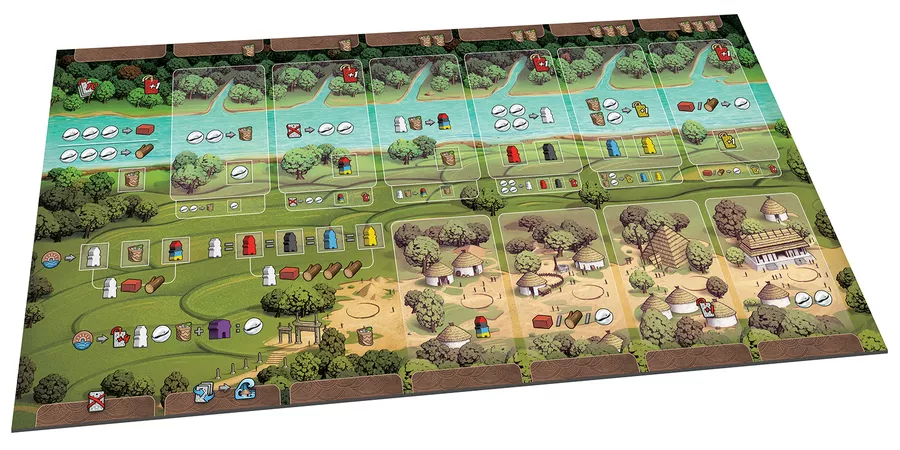
- Building new canals – canals are how one wins the game, build enough and you win. However, there are a few things of which to be wary. Building a new canal often gives the “reward” of eliminating one of your townsfolk cards and often increases the rate at which barbarians appear. It’s a (not) nice way of upping the pressure as the game goes on. Building a canal also unlocks a new place to put a building, which is very nice (see building new buildings below.)
- Buying new townsfolk cards – always an important move since every time one runs through their entire deck of townsfolk cards the flood moves forward one space. A small townsfolk deck means the flood will be moving faster.
- Defeating barbarian cards – barbarian cards share the tableau of the townsfolk cards and are typically defeated by spending the various colored worker tokens. Defeated barbarians do give a minor resource reward – every little bit helps. As the game progresses, fewer townsfolk cards become available and more barbarians appear. Undefeated barbarians must be appeased (spending workers or other resources) or they will remove townsfolk cards from your deck (very bad!) Undefeated barbarians (appeased or not) stick around for the next turn, limiting the new townsfolk cards for purchase and can chain out of control as they need to be appeased again or defeated.
- Building new buildings – this is the heart of the engine-building portion of the game and it is one where the designers really managed to capture the feel of a euro-style engine building game in a solo-only play experience. There isn’t even a dummy player to go up against. There are three types of buildings available to be built. Note, buildings must be placed on open build spaces. Players start with only one space, but free up more spaces as they build more canals across the top of the board.
- Farms are the simplest building. There are three of them and each one grants a resource at the start of every player turn – either a provision, a white worker, or a colored worker.
- The Outposts don’t actually provide a resource. Instead, they have the special power of making specific colored workers equivalent to a white worker. If you’ve built the red and the blue worker outposts, you can spend any of those colors as any other. For example, a blue worker would count as a white or a red worker, as needed.
- Huts are my favorite building as they unlock two important engine building features. The most obvious one is that they unlock a worker placement location. On one’s turn, a worker (any color) can be placed there to gain resources (goods or even other workers) and the worker used will be returned to the player’s supply at the end of the turn. A built hut also unlocks a space beneath it that can hold a townsfolk card. A townsfolk can be placed in this location and then that card will provide a specific resource at the start of every turn for the rest of the game. Thus, each Hut provides a double-whammy of bonuses – a worker placement spot for goodies during one’s turn, and a spot to place a townsfolk card that grants goodies at the start of every turn.
Of course, the game is not meant to be played as a one-off, it is set up to be played multiple times over a (non-destructive) legacy campaign. The game comes with a special deck of cards and a story booklet that combine to create an ever changing game. Typically the story book provides an ongoing background story and then has the player add/remove/or replace cards. In general, the story revolves around the player as a great architect and entries in the book are letters he writes back home about his adventures and problems. Story entries are triggered in several ways, but are usually triggered by the reveal of a specific card in the game. When revealed that card is usually replaced with another (or more than one) for use in all further games. In this way, there are several little story branches that flow through the game, slowly (ramping up the difficulty and (sometimes) the complexity.
The overarching goal is to win the game seven times before losing seven times. At the end of every game, either a victory card or a defeat card is revealed. It will point to an entry in the story book which will provide some flavor as well as add new cards into the game. A victory earns a player a nice new complication (new, more difficult barbarians, for example) while a loss triggers the addition of favorable abilities or new cards.
Due to the random nature of the reveal of some cards, things are not going to progress the same way in every campaign. Some game cards will trigger at different times and the defeat cards send a player to one of two different story entries, depending on whether it was a loss due to the flood or the barbarians. Due to the variability, the rulebook claims a player will typically only see about 60% of the new story content in one playthrough, making it possibly worthwhile to give the campaign a second go.
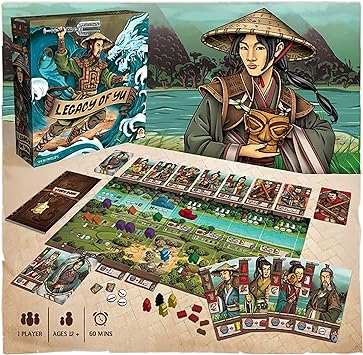
Verdict:
I must say that this game has made an impression on me. So many solo games make me feel like I’m playing against some sort of robotic opponent that just automatically generates points while simultaneously trying to simply get in my way to prevent me from pursuing my personal strategy. Legacy of Yu has no set opponent. Instead there is the double time pressure of the barbarians and the flood. The flood is basically a fixed time clock, as you lose if it ever passes your canals. However, building canals quickly will trigger additional barbarians entering the game. Getting too far ahead in canals before establishing a good economic engine to deal with barbarians is not a very strategic decision. Thus, there is a nice balancing act of slowly building canals to give oneself time to build up resources and buildings in order to stay ahead of barbarians, but not so slowly that the flood overtakes you. The thing I like the best is that there isn’t a robot opponent. It is just me against the flood and the barbarians. I’m free to spend and build whatever I want without something artificially hindering my choices. I simply have to be sure to make good choices.
As for the campaign story, it did start to wear on me a bit. There are only so many letters home about building canals before they start to wash together. Sure, there are memorable story moments (often ending with the inclusion of a new card) that I liked but many others just sort of passed by. The best ones were story elements slowly developed over the course of several plays that made small adjustments to the gameplay itself.
The winning and losing cards were an interesting balancing mechanism. Wins treated you to new, harder cards while losses gave you new (usually ongoing for future games) advantages. I managed to win a couple and lose a couple games near the start of the campaign so I got to see both at work. Early on, I feel like I drew a rather powerful loss-card benefit so that helped me greatly in the long run – I think I only lost 3 games before winning all 7. While one would meet up with all 7 of the win cards (hopefully) in a campaign, there will be loss cards unseen (I haven’t seen 4 of them) and since loss cards go to different stories depending on the trigger (flood vs barbarians) I think the largest variance from campaign to campaign would be the advantages gained from loss cards. This also means that a player who tends to win more often will see less variation over several campaign playthroughs.
In summary, I thoroughly enjoyed my playthrough of Legacy of Yu. I really felt like I was playing a classic euro-style engine builder game even though I was the only one at the table. Due to the nature of reviewing games, I’m often looking down the pipe to see what’s next but Legacy of Yu kept me coming back again and again to finish the entire campaign. I would normally give or trade away the game at this point but I enjoyed it enough to entertain the idea of giving it another go. I’m not so sure I’ve only seen 60% of the content, but I have some interest in seeing what might happen after two or three new adjustments are made to the game due to suffering a loss. I give Legacy of Yu a big thumbs up to fans of engine building and anyone looking for a solo game that isn’t designed around beating an opponent. I have mixed feelings about the long-term viability of a second or third go-round to the campaign but my first time through was worth the price of admission.
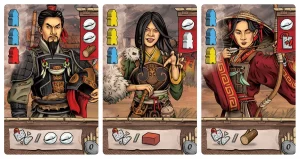
Kid Factor
The campaign story in Legacy of Yu certainly brings out the theme of the game in more depth than most board games. Expect themes of barbarians attacking, theft, loss, and homesickness (of the main character of the story who is writing to his wife back home.) None of these go into gory detail but the consequences are still present. The game lists 12+ and that’s probably a solid number. An astute, motivated younger child (who is a good reader – as there is plenty of background text in the campaign story) may be able to carry the game off, but there are exceptions for any number one might throw out.





Discussion Area - Leave a Comment